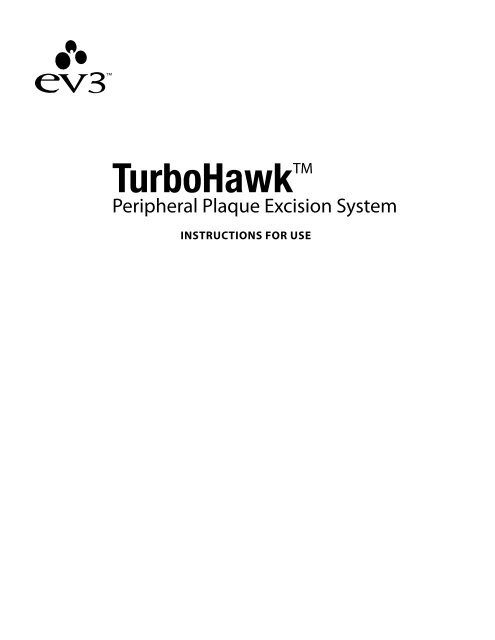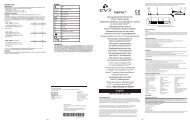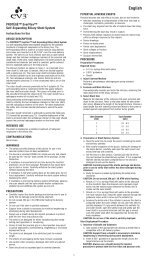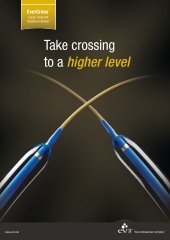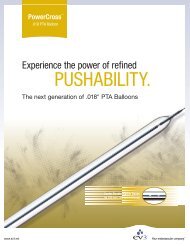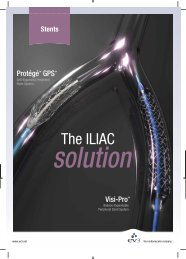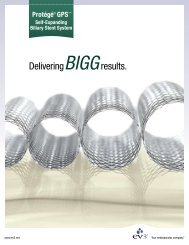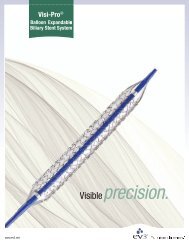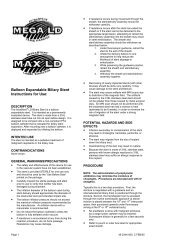TurboHawk TM Peripheral Plaque Excision System IFU (PDF - eV3
TurboHawk TM Peripheral Plaque Excision System IFU (PDF - eV3
TurboHawk TM Peripheral Plaque Excision System IFU (PDF - eV3
You also want an ePaper? Increase the reach of your titles
YUMPU automatically turns print PDFs into web optimized ePapers that Google loves.
<strong>TurboHawk</strong> <strong>TM</strong><br />
<strong>Peripheral</strong> <strong>Plaque</strong> <strong>Excision</strong> <strong>System</strong><br />
InstructIons for use
DevIce DescrIptIon<br />
The <strong>TurboHawk</strong> <strong>Peripheral</strong> <strong>Plaque</strong> <strong>Excision</strong> <strong>System</strong> (<strong>TurboHawk</strong> Catheter and Cutter<br />
Driver) is designed for the treatment of de novo and restenotic atherosclerotic<br />
calcified and non-calcified lesions located in native peripheral arteries. When used in<br />
complex, hard, calcified lesions, the <strong>TurboHawk</strong> Catheter should be paired with the<br />
SpiderFX Embolic Protection Device to mitigate risk of distal embolization that may<br />
be generated by the breakdown of heavily calcified plaque. The <strong>TurboHawk</strong> Catheter<br />
consists of a flexible shaft designed to track over a 0.014” guidewire. At the distal<br />
end of the <strong>TurboHawk</strong> Catheter is a small cutting assembly comprised of a rotating<br />
inner blade contained within a tubular housing. The proximal end of the <strong>TurboHawk</strong><br />
Catheter contains a connector and cutter positioning lever (Thumb Switch) designed<br />
to fit into the Cutter Driver. The Cutter Driver is a handheld, disposable, batterydriven<br />
unit (Catalog No. FG-02550), which powers the device. For information about<br />
the SpiderFX Embolic Protection Device, reference the Instructions for Use provided<br />
with the device.<br />
The <strong>TurboHawk</strong> <strong>Peripheral</strong> <strong>Plaque</strong> <strong>Excision</strong> <strong>System</strong> has two switches: 1) the Cutter<br />
Driver main power switch and 2) the <strong>TurboHawk</strong> Catheter thumb switch. The Cutter<br />
Driver main power switch supplies power to the device when turned ON. The<br />
<strong>TurboHawk</strong> Catheter thumb switch activates the drive shaft and engages the cutter<br />
when pulled proximally to the ON position. With the cutter engaged, the <strong>TurboHawk</strong><br />
Catheter is slowly advanced across the lesion, shaving occlusive material from the<br />
artery. The excised tissue is captured and stored in the tip of the device. The cutting<br />
process is completed by advancing the <strong>TurboHawk</strong> Catheter thumb switch distally<br />
deactivating the drive shaft and disengaging the cutter. The <strong>TurboHawk</strong> Catheter<br />
thumb switch is fully advanced distally to the OFF position in order to pack the<br />
excised plaque into the tip. This cutting sequence is repeated as necessary to achieve<br />
the desired degree of plaque excision.<br />
table 1: Key turboHawk catheter specifications<br />
catalog number tHs-Ls-c tHs-LX-c<br />
Model LS-C LX-C<br />
Usable Length 104 cm 104 cm<br />
Tip Length 6.0 cm 9.0 cm<br />
Maximum Catheter Profile 2.7mm 2.7 mm<br />
Minimum Sheath Size 7F (0.100”) 7F (0.100”)<br />
Shape Set Mechanical Mechanical<br />
Maximum Guidewire Diameter 0.014” 0.014”<br />
Vessel Range 3.5 mm - 7.0 mm 3.5 mm - 7.0 mm<br />
ILLustratIon anD nomencLature<br />
catheter:<br />
Cutter positioning lever (Thumb Switch)<br />
Flush port Torque knob<br />
Cutter window<br />
Closed<br />
Cutter window<br />
Open<br />
Strain relief<br />
Tip deflected<br />
2<br />
cutter Driver:<br />
Main power switch<br />
Catheter release button<br />
note: The Cutter Driver is protected against electrical shock (defibrillation proof-<br />
type CF). Keep the Cutter Driver dry (IPX0). Not suitable for use in the presence of a<br />
flammable anesthetic mixture. The Cutter Driver operates in a continuous mode and<br />
is internally powered by batteries.<br />
InDIcatIons for use<br />
The <strong>TurboHawk</strong> <strong>Peripheral</strong> <strong>Plaque</strong> <strong>Excision</strong> <strong>System</strong> is intended for use in atherectomy<br />
of the peripheral vasculature. The <strong>TurboHawk</strong> Catheter is indicated for use in<br />
conjunction with the SpiderFX Embolic Protection Device in the treatment of<br />
severely calcified lesions. The <strong>TurboHawk</strong> Catheter is NOT intended for use in the<br />
coronary, carotid, iliac or renal vasculature.<br />
contraInDIcatIons<br />
• Do not use in the coronary arteries, carotid artery, or in the iliac or renal<br />
vasculature.<br />
• Do not use for in-stent restenosis at the peripheral vascular site.<br />
• Any evidence or history of intracranial bleeding or aneurysm<br />
• Any history of thrombotic or hemorrhagic stroke<br />
• Known hypercoagulable state or coagulopathy or abnormal bleeding<br />
tendency<br />
• Evidence of intraocular hemorrhage by opthalmoscopic exam<br />
• History of thrombocytopenia or thrombocytosis<br />
• Severe trauma, fracture, major surgery or biopsy of a parenchymal organ<br />
within the past 3 months<br />
• Prolonged cardiopulmonary resuscitation<br />
• Endoscopic peptic ulcer disease in the past 3 years or gastrointestinal<br />
bleeding within the past 3 months<br />
• Genitourinary bleeding within the past 3 months<br />
• Severe persistent hypertension (systolic pressure >180 mmHg)<br />
• Allergy or intolerance to aspirin<br />
WarnIngs<br />
• The <strong>TurboHawk</strong> Catheter should be paired with the SpiderFX Embolic<br />
Protection Device when used in complex, hard, calcified lesions to mitigate<br />
risk of distal embolization that may be generated by the breakdown of<br />
heavily calcified plaque.<br />
• The <strong>TurboHawk</strong> Catheter should only be used by physicians trained in<br />
percutaneous peripheral interventional procedures.<br />
• Use of this device should be limited to facilities where surgical support is<br />
readily available in the event of a serious complication.<br />
• The <strong>TurboHawk</strong> Catheter may only be used with the Cutter Driver.<br />
• This device is supplied STERILE for single use only. Do not reprocess or<br />
re-sterilize. Reprocessing and re-sterilizing could increase the risk of patient<br />
infection and risk of compromised device performance.<br />
• Do not use the device after the labeled “Use By” expiration date.<br />
• This device is not to be used in the presence of combustible or flammable<br />
gases, anesthetics, or cleaners/disinfectants.<br />
• Always use direct fluoroscopic observation when manipulating the<br />
<strong>TurboHawk</strong> Catheter in the peripheral vessels. If resistance is met during<br />
manipulation, determine the cause of the resistance before proceeding.<br />
• Never advance the distal tip of the <strong>TurboHawk</strong> Catheter near the floppy end<br />
of the guidewire. A <strong>TurboHawk</strong> Catheter advanced to this position may not<br />
follow the guidewire when it is retracted and cause the guidewire to buckle<br />
into a loop. If this occurs, the catheter and guidewire should be removed<br />
together to prevent potential damage to vessel walls. If resistance is still felt,<br />
the sheath should also be removed as part of the unit.<br />
• The cutter section of the <strong>TurboHawk</strong> Catheter is a rigid component. Do not<br />
use excessive force or torque to advance the catheter as vessel trauma and/<br />
or device failure may result.<br />
• Do not use the <strong>TurboHawk</strong> Catheter in bends in excess of 90°. Doing so may<br />
result in device failure.<br />
• Operation of the device with the blade partially opened or closed could<br />
result in vessel trauma or possible embolization of previously excised tissue.<br />
• When using the <strong>TurboHawk</strong> Catheter with the SpiderFX Device, never<br />
advance the distal tip of the catheter near the SpiderFX Device proximal<br />
radiopaque marker band. Contact with the marker band may result in distal
embolization of the captured debris, as well as vessel trauma or device<br />
failure.<br />
• The storage capacity of the catheter tip must not be exceeded or<br />
embolization of excised tissue fragments may result.<br />
• If the SpiderFX Device is not used, exceeding the recommended maximum<br />
length of cut and/or number of cut passes prior to removing and emptying<br />
the device will increase the risk of embolization of excised tissue fragments.<br />
• If the <strong>TurboHawk</strong> Catheter does not advance easily, close the cutter by<br />
advancing the Thumb Switch. Excessive force should not be used to advance<br />
the Thumb Switch. Device repositioning or predilatation may be required.<br />
• Avoid excessive movement of the <strong>TurboHawk</strong> Catheter within the vessel at all<br />
times as doing so could result in embolization or vessel damage. In addition,<br />
excessive catheter manipulation with the cutter window open could result in<br />
embolization of previously excised tissue fragments.<br />
precautIons<br />
• Federal (U.S.A.) Law restricts this device to sale by or on the order of a<br />
physician.<br />
• Do not sharply bend or kink the <strong>TurboHawk</strong> Catheter shaft during handling<br />
as this could damage the device and impair its function.<br />
• Do not use excessive force, pinch, or bend the tip of the catheter when<br />
inserting the catheter through the hemostasis valve of the sheath. Using<br />
excessive force, pinching, or bending the tip may damage the device and<br />
impair its function.<br />
• Refer to table 1 Key <strong>TurboHawk</strong> Catheter Specifications for minimum sheath<br />
size requirements. Use of sheaths smaller than those recommended may<br />
compromise device performance.<br />
• When using the SpiderFX Device in combination with the <strong>TurboHawk</strong><br />
Catheter, the SpiderFX Filter must be deployed such that the proximal<br />
radiopaque marker is no less than 8cm (for LS-C use) or 11cm (for LX-C use)<br />
distal to the lesion. Failure to appropriately place the filter may compromise<br />
device performance.<br />
• The Guidewire MUST go through BOTH lumens; otherwise, the tip may be<br />
open. Operation of the device with the tip open could result in embolization<br />
of excised tissue.<br />
• Do not over tighten the hemostasis valve as this may inhibit smooth<br />
advancement and rotation of the <strong>TurboHawk</strong> Catheter or possibly damage<br />
the shaft.<br />
• If device is not rotating easily, do not torque the <strong>TurboHawk</strong> Catheter shaft<br />
more than 360° in one direction. Doing so could result in device failure such<br />
as shaft kinking or tip fracture. Device repositioning or lesion predilatation<br />
may be required.<br />
• Avoid using excessive force with tweezers when removing tissue to avoid<br />
damaging the flush window.<br />
• Cutting extended lengths in severely calcified lesions may result in cutter<br />
wear. If increased resistance is encountered during a cutting pass, this may<br />
indicate that the device needs to be replaced.<br />
potentIaL compLIcatIons / aDverse events<br />
Potential adverse events associated with use of this device and other interventional<br />
catheters include, but are not limited to the following:<br />
• Amputation<br />
• Aneurysm<br />
• Arterial dissection<br />
• Arterial perforation<br />
• Arterial rupture<br />
• Arterial spasm<br />
• Arteriovenous fistula<br />
• Bleeding complications<br />
• Death<br />
• Embolism and/or arterial thrombosis<br />
• Emergency or non-emergency arterial bypass surgery<br />
• Entry site complications<br />
• Hypotension<br />
• Infection<br />
• Ischemia<br />
• Restenosis of the treated segment<br />
• Total occlusion of the peripheral artery<br />
• Vascular complications which may require surgical repair<br />
3<br />
summarY of DefInItIve ca ++ stuDY<br />
DEFINITIVE Ca ++ was a prospective, multi-center, non-randomized, single-arm<br />
study to evaluate the safety and effectiveness of the SilverHawk/<strong>TurboHawk</strong><br />
<strong>Peripheral</strong> <strong>Plaque</strong> <strong>Excision</strong> <strong>System</strong>s and the SpiderFX Embolic Protection Device<br />
for the treatment of moderate to severely calcified peripheral arterial disease in<br />
the superficial femoral and/or popliteal arteries. An independent Angiographic<br />
Core Laboratory and a Clinical Events Committee (CEC) were employed to ensure<br />
unbiased review and classification of events and endpoints. 133 subjects from 17<br />
centers were enrolled. A summary of safety and effectiveness data is provided in the<br />
following table.<br />
table 2: DefInItIve ca ++ summary of safety and effectiveness<br />
parameters<br />
results<br />
angiographic<br />
site reported core Laboratory<br />
reported<br />
Baseline Demographics<br />
Age (mean ± SD) 69.7 ± 9.8<br />
Male 71.4% (95/133)<br />
Severe calcification 81.0% (136/168)<br />
Reference vessel diameter (mm) [mean ± SD (N)] 4.9 ± 0.9 (168)<br />
Target lesion length (mm) [mean ± SD (N)] 39.0 ± 27.0 (168)<br />
Pre-procedure diameter stenosis (%) [mean ± SD (N)]<br />
primary effectiveness endpoint<br />
76.5 ± 15.4 (168)<br />
Successful revascularization<br />
( ≤ 50% residual diameter stenosis following plaque<br />
excision)<br />
97.0% (162/167) 92.0% (150/163)<br />
primary safety endpoint (per angiographic core Laboratory review and cec adjudication)<br />
30-day MAE-Free rate 93.1% (122/131)<br />
Death 0.0% (0/131)<br />
Acute myocardial infarction 0.8% (1/131)<br />
Dissection, target vessel (C) 0.0% (0/131)<br />
Dissection, target vessel (grade D or greater) 0.8% (1/131)<br />
Clinical perforation, target vessel 2.3% (3/131)<br />
Pseudoaneurysm, target vessel 0.0% (0/131)<br />
Thrombosis, target vessel 0.8% (1/131)<br />
Distal embolism 2.3% (3/131)<br />
Amputation, above metatarsal line 0.0% (0/131)<br />
Clinically-Driven Target Vessel Revascularization 0.0% (0/131)<br />
The proportion of subjects event-free (per Angiographic Core Laboratory review and<br />
CEC adjudication) after 30 days was compared to a performance goal of 85.5% based<br />
on the TALON registry. The 30-day freedom from MAE rate was 93.1% (122/131). The<br />
95% lower confidence limit was 88.3% (as calculated by the Exact method), greater<br />
than the performance goal of 85.5%. Therefore, the primary safety endpoint was met<br />
as assessed by the Angiographic Core Laboratory.<br />
The primary effectiveness endpoint was successful revascularization of the target<br />
vessel (defined as less than or equal to 50% residual diameter stenosis following<br />
plaque excision), as adjudicated by the angiographic core laboratory. The proportion<br />
of lesions meeting this criterion was compared to a performance goal of 90.0%<br />
based on the TALON registry. Percent residual diameter stenosis results from the<br />
TALON registry were based on site-reported data. Per angiographic core laboratory<br />
assessment, the primary effectiveness criterion (≤ 50% residual diameter stenosis)<br />
was achieved in 92.0% (150/163) of lesions. The lower bound of the confidence<br />
interval is 87.6%. Therefore, the effectiveness endpoint was not met.<br />
The protocol mandated the use of an independent angiographic core laboratory<br />
to apply consistency and an unbiased assessment to residual diameter stenosis;<br />
however, the primary effectiveness performance goal was based on site-reported<br />
residual diameter stenosis from the TALON registry. The differences between siteassessed<br />
residual diameter stenosis data and angiographic core laboratory-assessed<br />
residual diameter stenosis data that were seen in this study are consistent in<br />
2, 3<br />
direction and magnitude with other studies.<br />
Per site assessment, the primary endpoint success criterion was achieved in 97.0%<br />
(162/167) of lesions. The lower bound of the confidence interval is 93.8%, which is<br />
above the 90% performance goal that was derived from the TALON site-reported<br />
data.<br />
Sources:<br />
1 Ramiah et al. J Endovasc Ther 2006;13:592-602.<br />
2 Popma et al. Am J Cardiol 80: 19K-25K, 1997.<br />
3 Werk et al. Circulation 118: 1358-1365, 2008.
HoW suppLIeD<br />
The <strong>TurboHawk</strong> Catheter and Cutter Driver are packaged and sterilized individually,<br />
but shipped in a single shelf carton. Both are intended for single patient use only.<br />
storage anD use conDItIons<br />
Store sterile packaged <strong>TurboHawk</strong> Catheters and Cutter Drivers in a cool dry place<br />
until ready to use. Do not expose to organic solvents, ionizing radiation, ultraviolet<br />
light or alcohol-based fluids.<br />
DIrectIons for use<br />
InspectIon<br />
1. Prior to use, carefully inspect the <strong>TurboHawk</strong> Catheter and Cutter Driver to<br />
verify that neither the sterile packaging nor the devices themselves have been<br />
damaged.<br />
2. Connect the <strong>TurboHawk</strong> Catheter to the Cutter Driver by inserting the proximal<br />
end of the catheter into the motor. Ensure the Thumb Switch aligns with the<br />
slot in the Cutter Driver. When fully inserted, the catheter connector will lock<br />
into the Cutter Driver. To remove the catheter from the Cutter Driver, depress<br />
the catheter lock release button and pull the catheter from the motor.<br />
note: To avoid accidental activation of the Cutter Driver, be sure the Thumb<br />
Switch is in the fully forward position prior to insertion into the Cutter Driver.<br />
3. To confirm functionality of the <strong>TurboHawk</strong> Catheter, advance and retract the<br />
Thumb Switch. Ensure that the motor turns on and off automatically and that<br />
the inner blade moves freely. The catheter tip should deflect and return to<br />
its original configuration as the cutter position is cycled. Advance the Thumb<br />
Switch to close the cutter window and turn the motor to OFF.<br />
note: The automatic motor control feature of the Cutter Driver can be<br />
disabled by using the main power switch. When the switch is up, the automatic<br />
motor control is enabled. When the switch is down, the Thumb Switch can be<br />
advanced and retracted without activating the motor.<br />
4. Inspect the shaft, cutter housing and distal tip for smooth transitions. Do not<br />
use the catheter if a sharp edge or protrusion is detected.<br />
cautIon: Do not sharply bend or kink the catheter shaft during handling<br />
as this could damage the device and/or impair its function.<br />
5. Check the catheter shaft for functionality of the hydrophilic coating. When<br />
wetted with sterile saline, the catheter shaft should feel slippery.<br />
note: To facilitate catheter handling, the proximal most portion of shaft is not<br />
coated.<br />
6. Should the catheter become kinked or damaged during use, replace the<br />
damaged catheter with a new catheter and return used device to ev3 for<br />
evaluation.<br />
preparatIon<br />
1. purge air from the catheter<br />
a. Fill a syringe (3cc or larger) with heparinized saline.<br />
b. Ensure the main power switch on the Cutter Driver is turned to the OFF<br />
position. Retract the Thumb Switch to the ON position to expose the<br />
cutter within the cutter window.<br />
c. Flush the <strong>TurboHawk</strong> Catheter shaft by attaching the heparinized<br />
saline filled syringe to the <strong>TurboHawk</strong> Catheter flush port. Gently apply<br />
pressure to the syringe until all air has been flushed from the <strong>TurboHawk</strong><br />
Catheter and saline is seen exiting the cutter window.<br />
d. Fully advance the Thumb Switch to the OFF and closed position.<br />
e. Submerge the Distal Flush Tool (DFT) in saline to lubricate the inner<br />
diameter.<br />
f. Submerge the catheter tip in saline to activate the hydrophilic coating.<br />
g. Loosen the DFT hemostasis valve and slide the DFT onto the distal end of<br />
the catheter. Align the DFT touhy knob just distal to the DFT Alignment<br />
Mark on the catheter. The flush window should be visible outside the seal.<br />
Tighten the touhy knob onto the catheter. See figure below the following<br />
note.<br />
note: After tightening, the DFT Alignment Mark mark should be just<br />
proximal of the touhy knob.<br />
TOUHY KNOB<br />
Dft alignment mark<br />
flush Window<br />
h. Rotate the distal end of the tip 180° clockwise to open the flush window.<br />
Point tip away from all individuals and/or cover with cloth to avoid spray.<br />
i. Fill a syringe (10 cc recommended) with saline and attach it to the luer<br />
on the DFT.<br />
j. Retract the Thumb Switch to the ON position to expose the cutter within<br />
the cutter window.<br />
k. Flush the tip until fluid exits the distal end of the tip.<br />
l. Fully advance the Thumb Switch to the closed and OFF position.<br />
m. Rotate the distal end of the tip back to the closed position such that the<br />
guidewire lumens align.<br />
4<br />
n. Loosen the DFT touhy knob, slide the DFT distally and remove from the<br />
tip of the catheter.<br />
o. Turn the main power switch of the Cutter Driver to the ON position.<br />
InsertIon anD use<br />
Once prepared, the catheter is ready for insertion into the patient.<br />
1. Insertion<br />
a. Prepare the patient and administer the appropriate anticoagulant and<br />
vasodilator therapy for standard intervention.<br />
b. Insert the appropriate sized sheath and hemostasis valve using standard<br />
techniques.<br />
cautIon: refer to table 1 Key turboHawk catheter specifications<br />
for minimum sheath size requirements. use of sheaths smaller than<br />
those recommended may compromise device performance.<br />
c. Angiographic assessment of the vessel should be performed to locate<br />
the target lesion.<br />
d. If severe calcium is detected in the treatment area, the SpiderFX Embolic<br />
Protection Device should be used in conjunction with the <strong>TurboHawk</strong><br />
Catheter. Refer to the SpiderFX Instructions for Use for appropriate filter<br />
sizing and deployment instructions.<br />
cautIon: When using the spiderfX Device in combination with the<br />
turboHawk catheter, the spiderfX filter must be deployed such that<br />
the proximal radiopaque marker is no less than 8cm (for Ls-c use)<br />
or 11cm (for LX-c use) distal to the lesion. failure to appropriately<br />
place the filter may compromise device performance.<br />
e. Using standard technique, place a guidewire across the target lesion.<br />
If using the SpiderFX Device, the capture wire will act as the primary<br />
guidewire for the <strong>TurboHawk</strong> Catheter.<br />
note: The minimum vessel diameter for the <strong>TurboHawk</strong> Catheter is 3.5 mm.<br />
f. Ensure that the Thumb Switch is in its fully advanced, i.e. closed and off,<br />
position.<br />
g. Carefully backload the end of the guidewire through the tip of the<br />
<strong>TurboHawk</strong> Catheter, making sure the guidewire travels through BOTH<br />
guidewire lumens and exits proximal to the cutter.<br />
cautIon: the guidewire must go through BotH lumens,<br />
otherwise, the tip may be open. operation of the device with the tip<br />
open could result in embolization of excised tissue.<br />
h. Loosen the hemostasis valve (if applicable) and carefully insert the<br />
<strong>TurboHawk</strong> Catheter into the sheath.<br />
i. During insertion, hold the device close to the sheath hub and ensure<br />
axial alignment of the catheter tip with the hemostasis valve.<br />
cautIon: Do not use excessive force, pinch, or bend the tip of the<br />
catheter when inserting the catheter through the hemostasis valve<br />
of the sheath. using excessive force, pinching, or bending the tip<br />
may damage the device and impair its function.<br />
j. Retighten the hemostasis valve (if applicable) to prevent blood loss.<br />
cautIon: Do not over tighten the hemostasis valve as this may<br />
inhibit smooth advancement and rotation of the catheter or<br />
possibly damage the shaft.<br />
2. Lesion treatment<br />
a. Using fluoroscopic guidance, carefully advance the <strong>TurboHawk</strong> Catheter<br />
to the proximal edge of the target stenosis.<br />
WarnIng: the cutter section of the turboHawk catheter is a rigid component.<br />
Do not use excessive force or torque to advance the catheter as vessel<br />
trauma and/or device failure may result.<br />
WarnIng: Do not use the turboHawk catheter in bends in excess of 90°.<br />
Doing so may result in device failure.<br />
note: If the <strong>TurboHawk</strong> Catheter cannot be advanced across the lesion,<br />
it may be necessary to carefully remove the <strong>TurboHawk</strong> Catheter and<br />
pre-dilate the lesion with a small diameter balloon angioplasty catheter.<br />
b. Carefully rotate the <strong>TurboHawk</strong> Catheter blade opening toward the<br />
treatment site. Additional angiographic assessment should be performed<br />
to confirm catheter position in relation to the lesion.<br />
note: The cutter housing is radiopaque to facilitate angiographic<br />
visualization of the device orientation.<br />
proximal<br />
Distal<br />
Right Anterior/Posterior Left
In addition, a radiopaque ring is located just proximal to the distal most<br />
edge of the tip.<br />
cautIon: If turboHawk catheter is not rotating easily, do not<br />
torque the catheter shaft more than 360º in one direction. Doing so<br />
could result in device failure such as shaft kinking or tip fracture.<br />
Device repositioning or lesion predilatation may be required.<br />
c. To begin plaque excision, retract the Thumb Switch which will expose the<br />
rotating blade and deflect the catheter tip.<br />
note: When advancing or retracting the Thumb Switch, the switch must be<br />
moved until a “click” is felt at the end of the lever travel. This indicates that the<br />
catheter has achieved its FULLY retracted or FULLY advanced position.<br />
WarnIng: operation of the device with the blade partially opened or<br />
closed could result in vessel trauma or possible embolization of previously<br />
excised tissue.<br />
d. With the motor running, slowly advance the <strong>TurboHawk</strong> Catheter<br />
through the target lesion under fluoroscopic guidance.<br />
WarnIng: When using the spiderfX Device in combination with turbo-<br />
Hawk catheter, never advance the distal tip of the turboHawk catheter<br />
near the spiderfX Device proximal radiopaque marker band. contact with<br />
the marker band may result in distal embolization of the captured debris,<br />
as well as vessel trauma or device failure.<br />
Reference the following matrix for the length of cut and number of cutting passes that<br />
may be completed for each Catalog Number before removing and emptying the device.<br />
catalog # Length of cut # cuts per insertion*<br />
THS-LS-C 50 mm 1<br />
THS-LX-C 75 mm 1<br />
* If SpiderFX is used, multiple cuts may be made per insertion.<br />
WarnIng: the storage capacity of the turboHawk catheter tip must not be<br />
exceeded or embolization of excised tissue fragments may result.<br />
WarnIng: If the spiderfX Device is not used, exceeding the recommended<br />
maximum length of cut and/or number of cut passes prior to removing and<br />
emptying the device will increase the risk of embolization of excised tissue<br />
fragments.<br />
note: If using the SpiderFX Device, it should be frequently observed<br />
under fluoroscopy to verify that the filter has not become occluded with<br />
debris, resulting in slow/no-flow. If the filter becomes occluded or flow<br />
is compromised, the <strong>TurboHawk</strong> Catheter should be removed and the<br />
filter recovered. Once recovered, the filter cannot be reintroduced into<br />
the body. A new filter should be deployed per the SpiderFX Embolic<br />
Protection Device Instructions for Use.<br />
WarnIng: If the catheter does not advance easily, close the cutter by advancing<br />
the thumb switch. excessive force should not be used to advance<br />
the thumb switch. Device repositioning or predilatation may be required.<br />
e. Once the end of the target segment is reached, stop advancing the<br />
catheter. Carefully advance the Thumb Switch to close the cutter and<br />
turn off the Cutter Driver, this will be indicated by a tactile “click”.<br />
f. At this point, a combination of angiographic and/or intravascular<br />
ultrasound imaging should be used to assess the extent of plaque excision.<br />
note: If using the SpiderFX Device, verify that the filter has not become<br />
occluded with debris, prior to making additional cutting passes with the<br />
<strong>TurboHawk</strong> Catheter.<br />
g. If the SpiderFX is used, multiple cuts can be made per insertion. The<br />
<strong>TurboHawk</strong> may be re-advanced and positioned for the additional cut<br />
by repeating steps a) through f) if there is adequate storage capacity<br />
remaining in the tip (see note below).<br />
note: If the Thumb Switch cannot be fully advanced (after completing<br />
a cut) the tip may be at full capacity. Proceed to the Catheter and Tissue<br />
Removal sections.<br />
3. catheter removal<br />
a. The catheter should be carefully removed from the patient under<br />
fluoroscopic guidance.<br />
b. Final angiographic and/or intravascular ultrasound evaluation should be<br />
performed post <strong>TurboHawk</strong> Catheter treatment.<br />
4. tissue removal<br />
a. Offload the catheter from the 0.014” guidewire.<br />
b. Fully advance the Thumb Switch to the closed and OFF position. Turn the<br />
main power switch on the Cutter Driver to OFF.<br />
c. Gently wipe down the outside of the tip with wet gauze.<br />
d. Slide the DFT onto the distal end of the catheter. Align the DFT touhy<br />
knob just distal to the DFT Alignment Mark on the catheter. The flush<br />
window should be visible outside the seal. Tighten the touhy knob onto<br />
the catheter. See figure below the note.<br />
note: After tightening, the DFT Alignment Mark should be just proximal<br />
of the touhy knob.<br />
5<br />
TOUHY KNOB<br />
flush Window<br />
Dft alignment mark<br />
e. Rotate the distal end of the tip 180° clockwise to open the flush window.<br />
Point tip away from all individuals and/or cover with cloth to avoid spray.<br />
f. Fill a syringe (10 cc recommended) with saline and attach the syringe to<br />
the luer on the DFT.<br />
g. Retract the Thumb Switch to the ON position to expose the cutter within<br />
the cutter window.<br />
h. Flush the tip with one constant stroke of 5-10 cc/sec. (Repeat if necessary<br />
to remove tissue.)<br />
i. Use tweezers to retrieve exposed tissue from the flush window if it does<br />
not fully exit the window.<br />
cautIon: avoid using excessive force with tweezers when removing<br />
tissue to avoid damaging the flush window.<br />
j. Fully advance the Thumb Switch to the closed and OFF position.<br />
k. Rotate the distal end of the tip back to the closed position such that the<br />
guidewire lumens align.<br />
l. Loosen the DFT touhy knob, slide the DFT distally and remove from the<br />
tip of the catheter.<br />
m. Turn the main power switch of the Cutter Driver to the ON position.<br />
5. repeated Insertion and use<br />
a. If additional insertions are to be made, repeat from the Insertion and<br />
use section, Step 1c.<br />
b. This cutting sequence can be repeated as necessary to achieve the<br />
desired degree of plaque excision.<br />
note: In vitro testing in severely calcified cadaver lesions has<br />
demonstrated minimal cutter wear after cutting calcified lesions totaling<br />
500mm in length. Device performance was maintained throughout<br />
testing.<br />
cautIon: cutting extended lengths in severely calcified lesions may<br />
result in cutter wear. If increased resistance is encountered during a<br />
cutting pass, this may indicate that the device needs to be replaced.
aBout tHIs manuaL<br />
Please read this manual and follow its instructions carefully. The words WARNING,<br />
CAUTION and NOTE convey special meanings. When they are used throughout this<br />
manual, they should be carefully reviewed to ensure the safe and effective operation<br />
of this product.<br />
WarnIng: A WARNING indicates that the personal safety of the patient or physician<br />
may be involved. Disregarding a WARNING could result in injury to the patient or<br />
physician.<br />
cautIon: A CAUTION indicates that particular service procedures or precautions<br />
must be followed to avoid possible damage to the product.<br />
note: A NOTE indicates special information to facilitate use of the product, or to<br />
clarify important information.<br />
Follow local governing ordinances and recycling plans regarding disposal or<br />
recycling of device components. Do not incinerate the Cutter Driver unit, as the<br />
enclosed batteries may explode at excessive temperatures.<br />
This equipment has been tested and found to comply with the EMC limits for the<br />
Medical Device Directive 93/42/EEC (EN 55011 Class B and EN 60601-1-2). These<br />
limits are designed to provide reasonable protection against harmful interference in<br />
a typical medical installation. The equipment generates, uses and can radiate radio<br />
frequency energy and, if not used in accordance with the instructions, may cause<br />
harmful interference to other devices in the vicinity. However, there is no guarantee<br />
that interference will not occur in a particular setting. If this equipment does cause<br />
harmful interference with other devices, which can be determined by turning the<br />
equipment off and on, the user is encouraged to try to correct the interference by<br />
one or more of the following measures:<br />
• Reorient or relocate the receiving device<br />
• Increase the separation between the equipment<br />
• Consult the manufacturer or field service technician of the equipment<br />
experiencing interference for help.<br />
WarnIng: there are no user replaceable parts in the cutter Driver.<br />
The Batteries Directive, 2006/66/EC, introduces new requirements, effective<br />
September 26, 2008, regarding removability of batteries from waste equipment in<br />
EU Member States. To comply with this Directive, this device has been designed for<br />
safe removal of the batteries at end-of-life by a waste treatment facility. Infected<br />
units should be de-contaminated before they are sent for recycling. In the event<br />
that it is not possible to decontaminate the unit for recycling, the hospital should<br />
not attempt to remove the batteries from waste equipment. Continued disposal of<br />
small amounts of portable batteries to landfill and incineration is allowed under the<br />
Batteries Directive and Member State regulations.<br />
6<br />
WarrantY DIscLaImer<br />
Although this product has been manufactured under carefully controlled<br />
conditions, ev3 Inc. has no control over the conditions under which this product<br />
is used. ev3 Inc. therefore disclaims all warranties, both express and implied,<br />
with respect to the product including, but not limited to, any implied warranty<br />
of merchantability or fitness for a particular purpose. ev3 Inc. shall not be liable<br />
to any person or entity for any medical expenses or any direct, incidental or<br />
consequential damages caused by any use, defect, failure or malfunction of the<br />
product, whether a claim for such damages is based upon warranty, contract, tort<br />
or otherwise. No person has any authority to bind ev3 Inc. to any representation<br />
or warranty with respect to the product.<br />
The exclusions and limitations set out above are not intended to, and should not<br />
be construed so as to contravene mandatory provisions of applicable law. If any<br />
part or term of this Disclaimer of Warranty is held to be illegal, unenforceable or<br />
in conflict with applicable law by a court of competent jurisdiction, the validity of<br />
the remaining portions of this Disclaimer of Warranty shall not be affected, and<br />
all rights and obligations shall be construed and enforced as if this Disclaimer of<br />
Warranty did not contain the particular part or term held to be invalid.
THIS PAGE INTENTIONALLY LEFT BLANK<br />
7
8<br />
DefInItIon of sYmBoLs<br />
IQ<br />
IK<br />
Y Caution<br />
Main power ON Secondary power ON<br />
Main power OFF Secondary power OFF<br />
Catheter lock release<br />
Defibrillation-proof, type CF applied part<br />
Sterilized using ethylene oxide gas<br />
Sterilized using irradiation<br />
M Manufacturer N<br />
h Catalogue Number g<br />
P<br />
Authorised representative in<br />
the European community<br />
p Keep Dry w<br />
H Use By D<br />
L<br />
Do not use if package is<br />
damaged i<br />
Date of Manufacture<br />
Lot Number<br />
Rx Only For prescription use only<br />
Keep away from sunlight<br />
Do not reuse<br />
Telephone FAX Facsimile<br />
Consult instructions for use<br />
contact Information<br />
If you have any questions or comments regarding the use of this product contact:<br />
ev3 corporate World Headquarters<br />
peripheral vascular<br />
3033 Campus Drive<br />
Plymouth, MN 55441<br />
USA<br />
FAX<br />
manufactured at:<br />
Irvine, CA<br />
+1.763.398.7000<br />
+800.716.6700<br />
+1.763.398.7200<br />
www.ev3.net<br />
©2012 ev3 Inc. All rights reserved.<br />
<strong>TurboHawk</strong>, SilverHawk, and SpiderFX are<br />
trademarks of ev3 and may be registered<br />
in the U.S. and other countries.<br />
Protected under one or more of the<br />
following:<br />
US Patent 7,708,749; 7,749,147; 6,623,496;<br />
6,447,525. Non-US patents pending.<br />
501169-001(C) AUG/12


